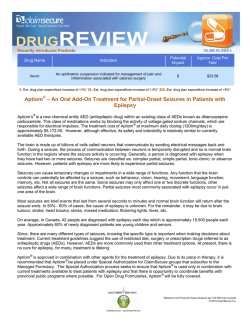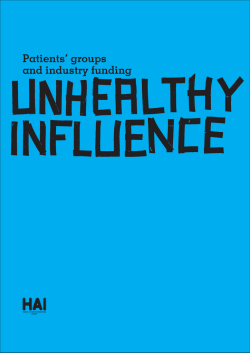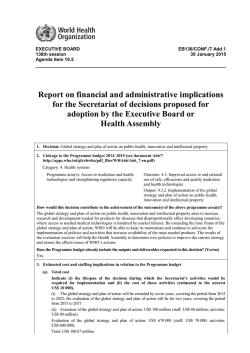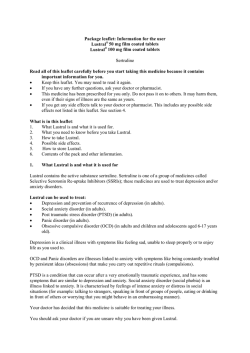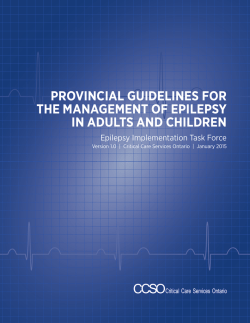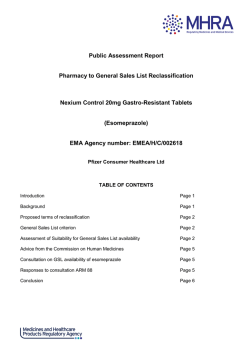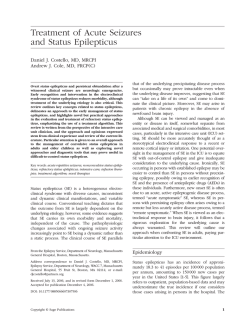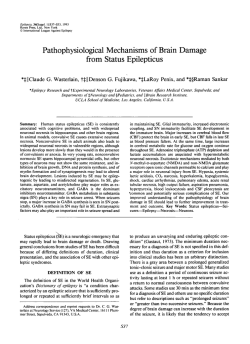
Medicines Optimisation Briefing
Medicines Optimisation Briefing The four principles of medicines optimisation* describe how healthcare professionals can enable patients to improve their quality of life and outcomes from medicines use by having a sustained focus on the need to optimise patients’ medicines. Patient experience Safe and effective I want the same colour, shape and make of my epilepsy medicines every time, not split packs of different makes, or medicines with foreign writing on them. I am worried that if I take a different brand I may have seizures, which will spoil my lifestyle, stop me driving and may lose me my job. I want to talk to someone who really knows and understands my condition. If I am not having seizures anymore, I want to know if I can stop the medicines. If I am still having seizures, why should I continue to take these? Steps you can take: Reassure me that you will do your best to provide me with the same epilepsy medicines every time in line with MHRA advice Make sure you understand my condition so that I have confidence in you Talk to me about why I should adhere to my medicines regimen and what the consequences could be if I stop Help me with repeat prescriptions so I don’t run out of my medicines Give me a photocopy of my latest prescription and/or photos of my medicines in case I run out or forget my medicines. www.rpharms.com Evidence – is the medicine appropriate? Anti-epileptic drugs (AEDs) are the main treatment for epilepsy, and up to 70% of people with epilepsy can stop having seizures with the right treatment. About 30% of patients with epilepsy do not respond to AEDs and continue to have seizures. AEDs are also used to suppress other seizure types and in other diseases (migraine, neuropathic pain and as mood stabilisers). Steps you can take: Talk to the patient about their condition. Are they seizure free? When did they last have a seizure? How often do they have them? Is this more or less than before? What is their treatment goal? Ask to see their care plan (if they have one) Ask the patient about their medicines; check what dose they take and when, as this may be different from what is written on the prescription Remind the patient to take their medicines at regular intervals throughout the day; understand and explain why this is especially important for AEDs Offer extra support for patients being titrated to higher (or lower) doses. * www.rpharms.com/medicines-safety/medicines-optimisation.asp AEDs can be very effective if taken regularly; they should not be stopped abruptly without expert support. If patients stop taking their medicines, there is a risk of poor control, an increased frequency of seizures and an increased risk of accident or injury. Many AEDs interact with other medicines (including OTC, complementary & recreational), food, and alcohol. Some AEDs (and indeed epilepsy) can affect memory and mood. Patients should know what triggers their epilepsy and to avoid them. Steps you can take: Make sure you have access to the patient’s entire medicines record, including OTC purchases and hospital-initiated medicines, and encourage them to keep a copy too Offer advice about alcohol and the possible effects on their seizure control, and on the side effects of AEDs If they have memory problems, provide reminder charts, compliance aids or suggest a suitable ‘app’ Discuss the possible side effects of treatment so the patient is better informed of the likely side effect profiles of their medicines Know the more serious consequences of poor seizure control. Medicines optimisation as part of routine practice Getting to know your patients with epilepsy can be very rewarding for you and them. They will come to you for advice once they know that you are interested and well informed. Work on your consultation skills so that you develop a shared agenda. Talk to them about what they hope to achieve with their medicines and help them to reach these goals. Steps you can take: Understand the whole picture – how are they taking their medicines? What does the patient want/need from their medicines? Help patients understand why they are taking these medicines and what they can expect in terms of side effects Make sure the patient has a consistent supply of their medicines Some people with epilepsy may have a chaotic lifestyle; for others, memory may be a problem. Support patients with appropriate adherence advice and compliance aids Signpost to patient groups and to their websites Be an active participant in the multi-disciplinary team that cares for patients with epilepsy. www.cppe.ac.uk EPILEPSY This medicines optimisation briefing focuses on patients with epilepsy and is designed for pharmacy professionals in any sector to use in their practice. Freddie is 17 and has epilepsy; he is well controlled on a stable dose of sodium valproate and has been seizure free for almost 2 years. He is expecting his provisional driving licence from the DVLA. He has just realised that he has run out of his sodium valproate tablets and has gone into a ‘mild panic’ as he does not want to risk having a seizure, as this will jeopardise his licence. Freddie and his mum call into the pharmacy and Freddie is able to obtain an emergency supply. The pharmacy technician recommends to Freddie and his mum that Freddie has a repeat prescription via the repeat dispensing service to reduce the chances of him running out of his medicines. The pharmacy technician also recommends a prescription reminder app that is available through the NHS choices health apps library. Susan has juvenile myoclonic epilepsy. She currently experiences an absence seizure every month and myoclonic jerks twice a week, a dramatic improvement on her previous situation. She was started on levetiracetam 6 months ago; initially at 250mg daily, but this has been gradually increased to 500mg twice daily. However, in her medicines use review (MUR) today she reports a problem, which she thinks is related to the medicines. In the last few weeks she has been getting more and more irritable, which is very uncharacteristic for her. The pharmacist discusses the fact that levetiracetam can cause irritability, usually on initiation, and encourages Susan to continue with the medicine for the immediate future, but to contact her epilepsy specialist nurse or neurologist as soon as possible. They also suggest that she keep a seizure diary to monitor her seizures and any side effects. Susan’s AED is gradually changed to lamotrigine, which suits her better. The pharmacist also helps to ensure that she has a consistent supply of her prescribed medicine, is aware of any possible side effects with the new medicine and knows what dose she is taking. Gemma’s usual seizure pattern is sporadic and her seizures are well controlled. She has been taking Tegretol ® prolonged release for a while and is settled on this medicine. However, she was given a different version of Tegretol (a parallel import) for around two months. This caused problems for Gemma as she started to have seizures regularly and they were more severe. Recently she was hospitalised following a tonic-clonic seizure, which resulted in a head injury. On discharge, the hospital pharmacist scheduled a MUR with the community pharmacist; at this MUR, Gemma and the pharmacist discussed how best to ensure that Gemma always receives a consistent supply of Tegretol. Lifestyle messages Control your alcohol intake to below recommended limits – it can affect how medicines work and lead to poor seizure control Weight gain (or loss) can be a side effect of some AEDs; ask for help from the pharmacy team to manage your weight Know what precipitates your seizures; these are some of the common triggers: stress, anxiety, alcohol, other medicines, recreational drugs, lack of sleep, irregular meals (which cause low blood sugar), flickering lights, screen time, menstruation, illnesses which cause fever. Keeping a seizure diary can help to identify your triggers Conception – if you are considering pregnancy, seek pre-conception advice from the neurology team. Where’s the evidence? NICE clinical guideline 137, technology appraisal 232, epilepsy pathway and quality standard www.nice.org.uk/Guidance/ Conditions-and-diseases/Neurological-conditions/Epilepsy Signposting patients DVLA website for advice on epilepsy and driving www.gov.uk/epilepsy-and-driving Epilepsy action www.epilepsy.org.uk Epilepsy society www.epilepsysociety.org.uk For SPCs and PILs www.medicines.org.uk Health talk online www.healthtalkonline.org/peoples-experiences/ nerves-brain/epilepsy/topics NHS Choices www.nhs.uk/conditions/epilepsy/pages/introduction.aspx NHS Choices health apps library apps.nhs.uk Self Care Auxiliary Aids www.medicinesresources.nhs.uk/upload/ documents/Communities/SPS_E_SE_England/Self%20Care%20 Auxiliary%20Aids-ESDW.pdf Side effects can and should be reported by both patients and pharmacists using the yellow card system www.yellowcard.mhra.gov.uk SUDEP action www.sudep.org Young epilepsy www.youngepilepsy.org.uk Where can I learn more about this? CPPE learning programmes www.cppe.ac.uk Consultation skills website www.consultationskillsforpharmacy.com MHRA safety advice about AEDs and changing products www.mhra.gov.uk and search ‘AEDs changing products’ Epilepsy society, for professionals www.epilepsysociety.org.uk/ professional-membership#.U-J0WvldXK0 Clinical knowledge summaries cks.nice.org.uk /epilepsy These materials have been published through a corporate sponsorship from Pfizer. www.rpharms.com www.cppe.ac.uk EPILEPSY Case studies
© Copyright 2025
